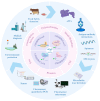Mitigating Antibiotic Resistance: The Utilization of CRISPR Technology in Detection
- PMID: 39727898
- PMCID: PMC11674896
- DOI: 10.3390/bios14120633
Mitigating Antibiotic Resistance: The Utilization of CRISPR Technology in Detection
Abstract
Antibiotics, celebrated as some of the most significant pharmaceutical breakthroughs in medical history, are capable of eliminating or inhibiting bacterial growth, offering a primary defense against a wide array of bacterial infections. However, the rise in antimicrobial resistance (AMR), driven by the widespread use of antibiotics, has evolved into a widespread and ominous threat to global public health. Thus, the creation of efficient methods for detecting resistance genes and antibiotics is imperative for ensuring food safety and safeguarding human health. The clustered regularly interspaced short palindromic repeats (CRISPR) and CRISPR-associated proteins (Cas) systems, initially recognized as an adaptive immune defense mechanism in bacteria and archaea, have unveiled their profound potential in sensor detection, transcending their notable gene-editing applications. CRISPR/Cas technology employs Cas enzymes and guides RNA to selectively target and cleave specific DNA or RNA sequences. This review offers an extensive examination of CRISPR/Cas systems, highlighting their unique attributes and applications in antibiotic detection. It outlines the current utilization and progress of the CRISPR/Cas toolkit for identifying both nucleic acid (resistance genes) and non-nucleic acid (antibiotic micromolecules) targets within the field of antibiotic detection. In addition, it examines the current challenges, such as sensitivity and specificity, and future opportunities, including the development of point-of-care diagnostics, providing strategic insights to facilitate the curbing and oversight of antibiotic-resistance proliferation.
Keywords: CRISPR; antibiotic detection; non-nucleic acid targets; nucleic acid targets.
Conflict of interest statement
The authors declare no conflicts of interest.
Figures



Similar articles
-
From resistance to remedy: the role of clustered regularly interspaced short palindromic repeats system in combating antimicrobial resistance-a review.Naunyn Schmiedebergs Arch Pharmacol. 2025 Mar;398(3):2259-2273. doi: 10.1007/s00210-024-03509-6. Epub 2024 Oct 15. Naunyn Schmiedebergs Arch Pharmacol. 2025. PMID: 39404843 Review.
-
Repurposing prokaryotic clustered regularly interspaced short palindromic repeats-Cas adaptive immune system to combat antimicrobial resistance.Future Microbiol. 2023 May;18:443-459. doi: 10.2217/fmb-2022-0222. Epub 2023 Jun 15. Future Microbiol. 2023. PMID: 37317864 Review.
-
CRISPR-Cas System: A New Dawn to Combat Antibiotic Resistance.BioDrugs. 2024 May;38(3):387-404. doi: 10.1007/s40259-024-00656-3. Epub 2024 Apr 11. BioDrugs. 2024. PMID: 38605260 Review.
-
Clustered Regularly Interspaced Short Palindromic Repeats (CRISPR)/Cas Advancement in Molecular Diagnostics and Signal Readout Approaches.J Mol Diagn. 2021 Nov;23(11):1433-1442. doi: 10.1016/j.jmoldx.2021.07.025. Epub 2021 Aug 25. J Mol Diagn. 2021. PMID: 34454111 Review.
-
Reinvigorating AMR resilience: leveraging CRISPR-Cas technology potentials to combat the 2024 WHO bacterial priority pathogens for enhanced global health security-a systematic review.Trop Med Health. 2025 Apr 2;53(1):43. doi: 10.1186/s41182-025-00728-2. Trop Med Health. 2025. PMID: 40176174 Free PMC article. Review.
References
-
- Antimicrobial Additives Market to Reach $5.63 Billion By 2030. [(accessed on 31 January 2024)]. Available online: https://www.grandviewresearch.com/press-release/global-antimicrobial-add....
-
- Su H.-C., Liu Y.-S., Pan C.-G., Chen J., He L.-Y., Ying G.-G. Persistence of antibiotic resistance genes and bacterial community changes in drinking water treatment system: From drinking water source to tap water. Sci. Total Environ. 2018;616–617:453–461. doi: 10.1016/j.scitotenv.2017.10.318. - DOI - PubMed
Publication types
MeSH terms
Substances
Grants and funding
LinkOut - more resources
Full Text Sources
Medical

